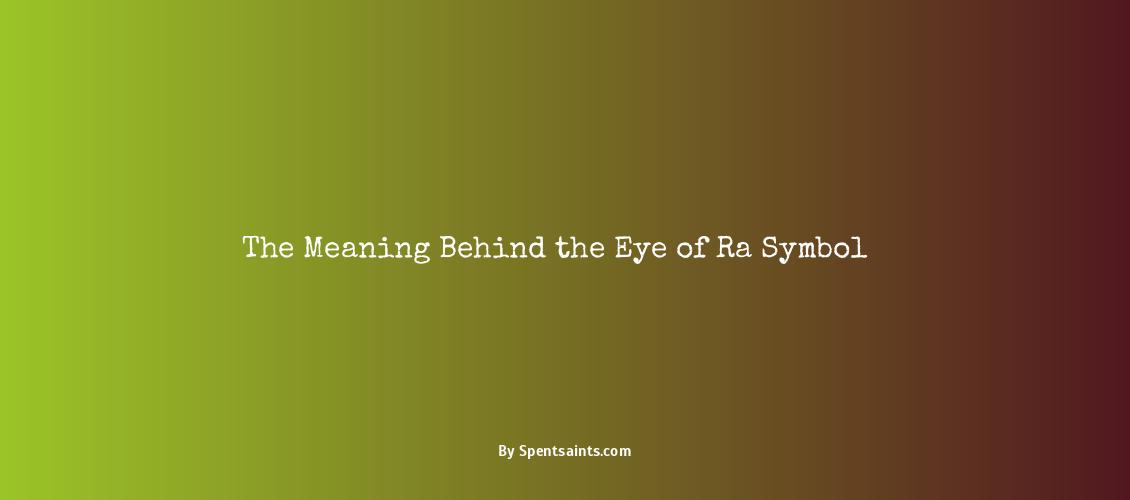The mysterious Eye of Ra holds deep symbolic meaning in ancient Egyptian mythology. But what does this iconic symbol actually represent? Understanding the history and significance of the Eye of Ra provides insight into ancient Egyptian beliefs.
The Eye of Ra has origins in myths involving the ancient Egyptian sun god, Ra. One of the most important deities, Ra represented light, warmth, and growth. According to legend, the Eye was a feminine counterpart to Ra, portrayed as his daughter or wife.
The Role of the Eye of Ra in Egyptian Mythology
Several myths provide context about the Eye of Ra’s origin and purpose. In one story, Ra’s children plotted against him. He dispatched the Eye as a fearsome weapon, showing her wrathful and destructive side. The Eye’s violence subdued Ra’s enemies and restored harmony. Her fury was unstoppable against those who rebelled against Ra’s authority.
In another key myth, the Eye goddess disobeyed and left Ra’s side. The absence of the Eye as Ra’s protector disturbed the sun god. To pacify her disruptive rage after the rebellion, Ra transformed the Eye into the uraeus – a coiled serpent worn on royal crowns. This affirmed the Eye’s role as protector and restored her to Ra’s side.
The Egyptians also portrayed the Eye of Ra as a fierce guardian. As the sun, Ra observed all things. Likewise, the Eye acted as his vigilant sentry, constantly surveying the realm. The Egyptians likened her to a lioness, fiercely defending and protecting Ra against any enemies or demons.
The Duality of the Eye of Ra
The myths highlight the Eye of Ra’s dual nature. She embodied fury and devastation as a dangerous force of wrath and destruction when disobeyed or slighted. But she also represented renewal and healing as the embodiment of Horus, the god associated with regeneration.
When furious and full of fiery energy, the Eye’s wrath could cause natural disasters, tempest storms, and widespread calamity. But she could also restore order from chaos, overcoming Apep, the serpent god representing darkness and evil. This duality reflects the ancient Egyptian principle of balance and interconnectedness between viciousness and restoration.
Decoded: The Meaning Behind the Symbol
So what does this mysterious symbol actually represent in Egyptian culture? The myths and legends provide rich symbolic meaning.
The Eye of Ra symbolized royal authority and absolute power. As an arm of Ra’s might, the Eye of Ra acted as an extension of his divine kingship and supremacy. Placement of the Eye on temples, crowns, scepters, and stelae proclaimed and strengthened Ra’s eternal sovereignty.
The Eye also represented the sun’s fiery energy. The Egyptians viewed the sun’s illuminating journey across the sky as Ra’s great voyage, visualized through the Eye as an emissary of light and heat. She also embodied the destructive heat of the sun’s rays.
In addition, the Eye symbolized divine providence watching over the citizens of Egypt. It became an emblem of protection, vigilance, vision, vitality, healing, and restoration. The Egyptians called upon the Eye for her life-preserving aid.
A Complex Meaning in a Simple Symbol
While a simple design, the Eye of Ra encapsulated a complex Egyptian belief system. It unified the concept of the sun’s vital energy with myths about the gods. For the Egyptians, the Eye showcased ideas of divine kingship, constant sight, the duality of benevolence and fury, and the restorative power of the sun.
As a protector wedded to Ra’s authority, the Eye of Ra stands for the heat, light, and authority of the sun disc itself. As an extension of Ra’s agency, the Eye Goddess inhabits dual roles: that of Ra’s creation and a being with her own autonomous power and myth cycle.
The Eye of Ra Vs. The Eye of Horus
The Eye of Ra is often confused with the Eye of Horus, but they symbolized distinct concepts to the ancient Egyptians.
The Eye of Horus represented regeneration, healing, and protection. It was associated with the god Horus as a symbol of his sacrifice when fighting Set for the throne of Egypt. The myth tells how Horus lost his left eye in this struggle, to be restored later as the Eye of Horus.
In contrast, the Eye of Ra personified the disc of the sun itself. It signified destructive heat, but also symbolized renewal. The Eye of Ra was linked to Ra’s authority and royal power; the Eye of Horus was connected more with healing and protection.
Subtle Distinctions Between the Eyes
While distinct in meaning, the two Eyes often blended together, viewed as the left and right eyes of one great deity. The Egyptians associated the solar Eye with Horus as Ra grew older, effectively uniting the Eyes of Ra and Horus.
Both Eyes embodied feminine energy and shared characteristics like being personified by goddesses and possessing the udjat or “sound eye” hieroglyph. Alongside their differences, the Eyes of Ra and Horus exemplified the interconnected Egyptian pantheon.
The iconic symbol maintains relevance today. Contemporary occultists and spiritualists still use the Eye of Ra. It represents esoteric wisdom, spiritual vision, mystic capabilities, and discipline.
In pop culture, the Eye of Ra appears in movies, games, and music as a symbol of ancient mystery, prophecy, magic, and divine favor. Jewelry featuring the Eye remains popular in Egypt and abroad as a token of protection and power.
This popularity endures because the Eye of Ra symbolizes the profound significance ancient Egyptians placed in the sun and its life-sustaining light. The myths reveal an intricate concept of cosmic order through the Eye’s relationship with Ra. Its cryptic meaning still captivates us today, reminding us of the intriguing history of ancient Egypt’s religion, culture, and society.
The Eye of Ra distills a complex belief system down to a simple, distinctive icon. Its enigmatic meaning continues to resonate, captivating our imagination millennia after its origins.

Dreams, spirit, growth – I explore them all. Laugh, learn, grow with me. Unlock your inner guru.
